The serve is the one part of squash where a player can decide how to play a shot without an opponent’s influence. This where you can take advantage of your opponent by making the shot tight to the wall and difficult to volley. After an effective serve, you have the opportunity to set yourself up to put more pressure on your opponent and let the game run in your favor by making even more difficult returns.
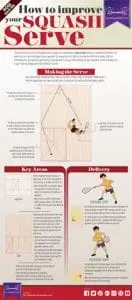
Contents
Backhand Deep Recovery
When playing a veteran player, a common strategy is to hit the ball deep into the corner on the backhand side of the court. In order to defend against this, it would be easy to say “don’t let the ball get deep in the corner.” However, that is easier said than done because squash is a fast-paced game.
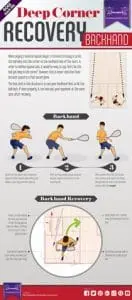
Squash Backhand Serve
The squash backhand serve is an effective serve if done correctly. The backhand swing enables you to spin the ball faster than you would on a forehand. With enough spin, a backhand serve creates unpredictable angles as the ball bounces off from the walls.
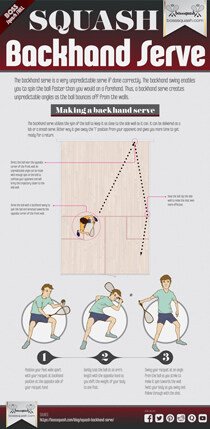
Squash Body Serve
The body serve in squash is made to catch your opponent off guard. It directs the ball towards the body of your opponent at high speed giving them less time to react. This serve is considered to be discourteous or unsportsmanlike by some players but is completely legal on the game.
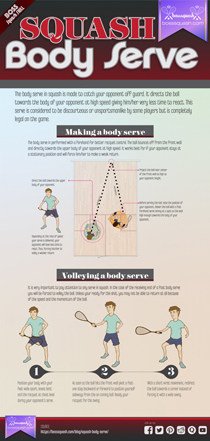
Squash Smash Serve
Similar to the lob serve, the smash serve in squash is an overhand serve that helps you take over the ‘T’ position when done correctly. This serve takes racquet control, timing and precise ball placement.
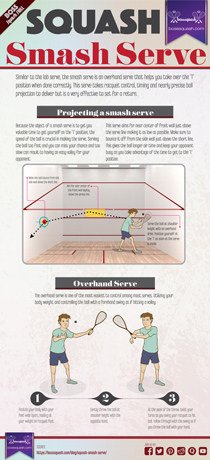
Squash Lob Serve
A lob serve is a serve in squash that is very hard to volley when done correctly. It takes advantage of the opposing upper corner of the court and the height at which the ball is projected. This leaves a very small room for your opponent at a very far position from the front wall.
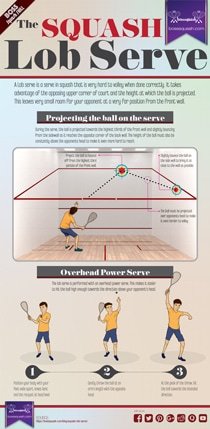
Trickle Boast Shot
The trickle boast shot in squash is an effective strategy to catch a point from your opponent. It makes use of the spinning momentum of the ball to make it react almost abnormally. In order to master the trickle boast shot, practice and an understanding of the physics involved is needed.
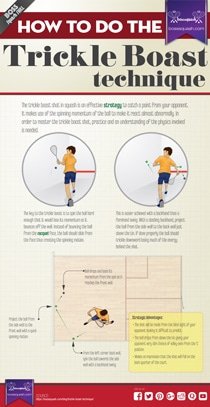
Squash Forehand Technique
Reverse Corner
The reverse corner shot is an effective kill shot in doubles squash. It is effective to hit in doubles when your opponent is behind you. You hit the opposite wall near the tin and close to the front wall. The ball should die quickly in the front court, sometimes leaving your opponent unable to react to the shot.
Most often this shot presents itself when your opponent on the opposite side hits a sub-par cross shot. Another likely time when this shot works is if your opponent on your side lobs back to you and the shot is not hugging the wall. One of the best feelings when you hit this shot (and even better when your opponent knows it is coming and they cannot get to the ball in time)! Singles squash players should not use this shot, if only for the element of surpise. Your coach and mentor will yell at you if you use it more than 1% of the time!
Skid Boast
The skid boast is an effective shot to get out of the deep backcourt corners. This shot is used more often in doubles squash because it is a tough shot to make in singles squash (squishy ball). You need to put a lot of spin on the ball. The goal is to get the ball cross-court and in the back corner.
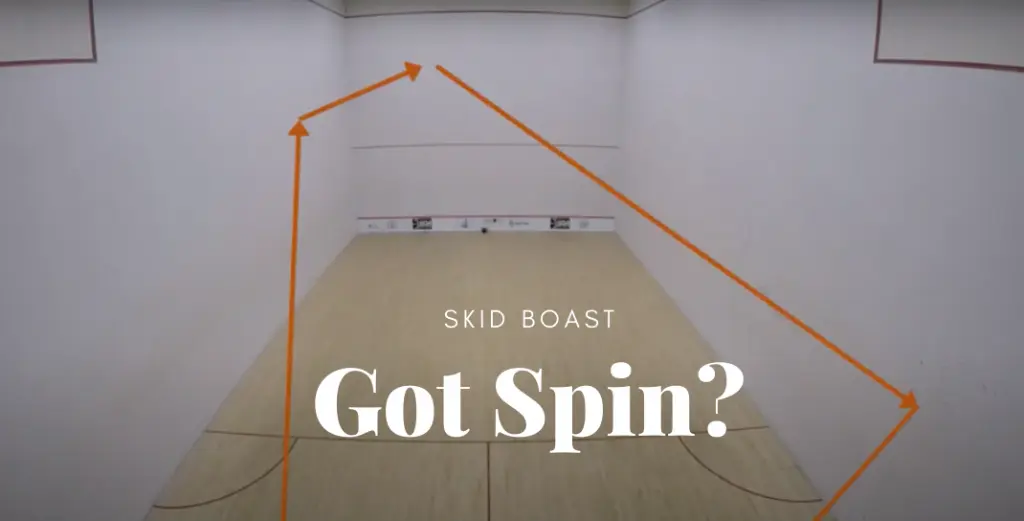
This shot can help change the rhythm of shots and increase the variety so your opponent does not anticipate your next move.
Attacking Boast
An attacking boast is a shot that hits the side wall and front wall. You want to plan for the ball to end in the front of the court. If that is the plan, you often want to hit the boast from the back of the court and hit in in the back middle part of the sidewall.
https://youtu.be/21QNb0GTK_c?t=58
Be careful executing this shot, as it can leave you in a vulnerable position in the back of the court. If you are hitting it in an advantagoeus court position you should be okay, but you want to have superior position on your opponent before hitting an attacking boast.
Defensive Boast
A defensive boast is a shot more attune to desperation. You usually will only hit this shot if it is your only option. Oftentimes this is done in the back of the court where you do not have court position or control. This shot is hit by using the back sidewall and aiming for the front opposite corner. If you get lucky, you may hit a nick and end the point! After hitting this shot you need to remember to get back to the T so you are not left vulnerable to your opponent’s next shot.
Straight Drive
Standard driving shot with a goal of hitting the ball above the midline on the front wall and bouncing the ball close to the wall in the back half of the court.
Racket head angled drive
Similar to the straight drive, but you angle your racquet slightly to give a cutting motion on the ball. This is not the same as a drop shot, which has a similar cutting motion. This shot is supposed to look the same as a straight drive but the ball will bounce closer to the middle. For baseball players, this is like a pitcher throwing a change-up after several fastballs. It is meant to throw off your timing and rhythm.
Power drive
A power drive is a shot hit just above the tin and meant to land in the frontcourt. This shot is often hit as a volley with your opponent in the back of the court. It is hit hard and above the tin to make your opponent react fast and get up to the frontcourt.
Crosscourt Drive
A crosscourt drive is a defensive shot used to keep your opponent moving away from the T. This shot can be used to always break a rhythm of several of the same shots in a row (oftentimes deep straight drives to the backhand side). With a crosscourt drive, you want to make sure you hit this shot above the midline so it has a higher probability chance of getting to the backcourt. If you hit this shot below the midline on the front wall, the probability increases that your opponent can cut the ball off and hit to an open spot in the court which is a far distance from where you are hitting.
Drop Shot
The drop shot is a great shot to use after a long rally or off the volley. When hitting off the volley it does not always have to be a perfect shot, but just one to get your opponent moving. This will set up your next shot that will put them away. You want to aim for just above the tin and take some power off the shot so the ball lands close to the front wall.
Backspin Drop Shot
Most often when you hit a drop shot, you will put backspin on it. The exception is when hitting off the volley. The chances to put backspin on it will often occur in a rally when you get in a good position to hit the ball after the first bounce (see video below).
When hitting a backspin drop from the back of the court, hit this when your opponent is expecting to move back. Notice in the video below the player at the T is already anticipating moving back. It is a subtle movement but enough for this to be a great shot. This is the only time to hit a drop from the back of the court. If not hit well and your opponent anticipates the drop coming, you are left in the back and have to hustle forward.
Topspin Drop Shot
This is a rare shot to see. You will rarely see a player hit a topspin drop shot on their backhand. This is almost always a shot hit on the forehand side. Oftentimes this shot is hit out of desperation or if you do not have proper positioning. One player I know hits this shot when his footwork is poor. Luckily his wrist skills are amazing which makes this a decent 1x/match shot for him.
The tough part about this shot is that when it goes by you to the front wall, it appears to travel like a weak straight drive. However, the topspin puts a “sinking” spin on the ball that can die quickly in the frontcourt. Aim this shot right above the tin because if it is left up your opponent will salivate over the opportunity.
Crosscourt Drop Shot
The crosscourt drop shot is best played off of a volley. Likely your opponent is in the back corner having retrieved a drive to the back by you. Their return shot is off the wall and in a volley position for you, and they are slow to get back to the T.
When hitting a crosscourt drop, it is more important to keep your footwork and racquet placement like you are going to hit another return back. You do not want to turn your body to “reveal” your drop shot. This shot is less about accuracy and more about the surprise. Hit the shot like a straight volley drop.
